 This advertisement for the El Capitan shows a Hi-Level coach (left) and several other photos of the train's interior (right).
This advertisement for the El Capitan shows a Hi-Level coach (left) and several other photos of the train's interior (right).
The two middle pictures on the right are of the Hi-Level lounge cars that would go on to become Amtrak's Pacific Parlour Cars.
 Even though this was a small part of
the ad, we were able to enlarge it - so you can get a good view of the
original interior of the Hi-Level lounge cars. This is a view of what
the upper level of the cars once looked like before undergoing several
refurbishments (which you will learn about below).
Even though this was a small part of
the ad, we were able to enlarge it - so you can get a good view of the
original interior of the Hi-Level lounge cars. This is a view of what
the upper level of the cars once looked like before undergoing several
refurbishments (which you will learn about below).
 While the upper level of the Hi-Level
lounges were excellent for sightseeing, those who wanted a coffee fix
could head down to the Kachina Lounge on the lower level of the car. As
the ad says, "Make yourself comfortable in the quite, intimate Kachina
coffee shop in the lower lounge..."
While the upper level of the Hi-Level
lounges were excellent for sightseeing, those who wanted a coffee fix
could head down to the Kachina Lounge on the lower level of the car. As
the ad says, "Make yourself comfortable in the quite, intimate Kachina
coffee shop in the lower lounge..."

 Above is another early advertisement
from the 1950's, promoting the new Hi-Level lounge car with the Kachina
Coffee Shop-Lounge below.
Above is another early advertisement
from the 1950's, promoting the new Hi-Level lounge car with the Kachina
Coffee Shop-Lounge below.
 Here is a luggage tag that you might have received in the 1950's if you were traveling on the El Capitan with the new Hi-Level equipment!
Here is a luggage tag that you might have received in the 1950's if you were traveling on the El Capitan with the new Hi-Level equipment!
 This is an image of the Santa Fe's Kachina - it was used by the railroad for many purposes.
This is an image of the Santa Fe's Kachina - it was used by the railroad for many purposes.
 This black and white photo is one of
the earliest photos that we could find from the 1950's of people
enjoying the new Hi-Level lounge cars.
This black and white photo is one of
the earliest photos that we could find from the 1950's of people
enjoying the new Hi-Level lounge cars.
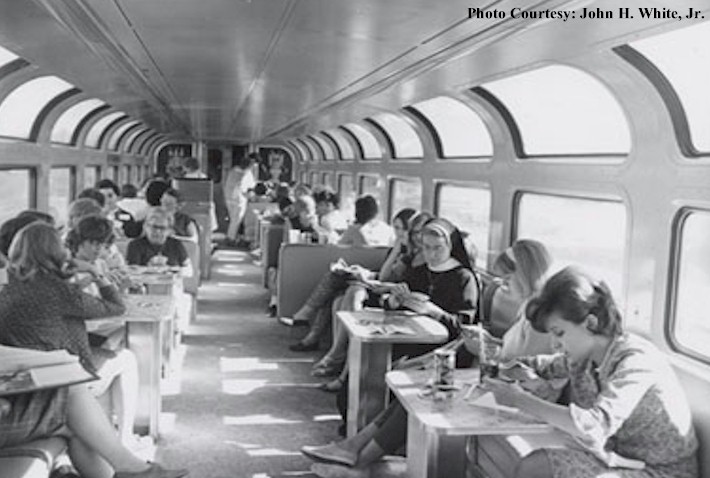 Here is another photo of people in a
quite crowded Santa Fe Hi-Level lounge car from the late 1950's or
early 1960's; notice the nun!
Here is another photo of people in a
quite crowded Santa Fe Hi-Level lounge car from the late 1950's or
early 1960's; notice the nun!
(PHOTO COURTESY: John H. White, Jr.)
 This photo was turned into a post card by the Santa Fe and were given out to passengers for promotional purposes on the El Capitan
This photo was turned into a post card by the Santa Fe and were given out to passengers for promotional purposes on the El Capitan
In the above post card, you will
notice the number of the car by the side of the door - #578. Did you
know that the original Hi-Level lounges were numbered #575, #576, #577,
#578. #579, and #580 by the Santa Fe? (#578 in the above photo would later become Amtrak Pacific Parlour Car #39973 -- Santa Lucia Highlands). Each of the six lounges could
seat 60 on the upper level. The seating was a mixture single seats and
two-and four-top tables. Nicknames for these cars included "Top of the
Cap" and "Sky Lounges". A glass top across two-thirds of the car
distinguished it from the rest of the Hi-Levels. As seen in some of the
photos we posted above, the lower level featured the Kachina Coffee
Shop and a lounge area with seating for 26 passengers. The lounge cars weighed 83
short tons. Under Santa Fe operation there were attendants on both
levels, and a newsstand on the upper level.
The Hi-Level lounges went into service on the Santa Fe in July 1956.
A typical train on the El Capitan
comprised two step-down coaches, five standard coaches, a lounge, and a
dining car. The Hi-Level cars continued in service after the Santa Fe
combined the El Capitan and Super Chief
in 1958. The Santa Fe also converted six single-level baggage cars to
baggage-dormitories (Nos. 3477–3482), with a spoiler at one end to
create a visual transition. The cars dated from the 1938 version of the
El Capitan.
Let's take a look at some more promotional pieces featuring the Hi-Level lounge cars from the late 1950's and early 1960's.
 The same image used for the post card posted earlier was used for this Santa Fe promotional brochure.
The same image used for the post card posted earlier was used for this Santa Fe promotional brochure.
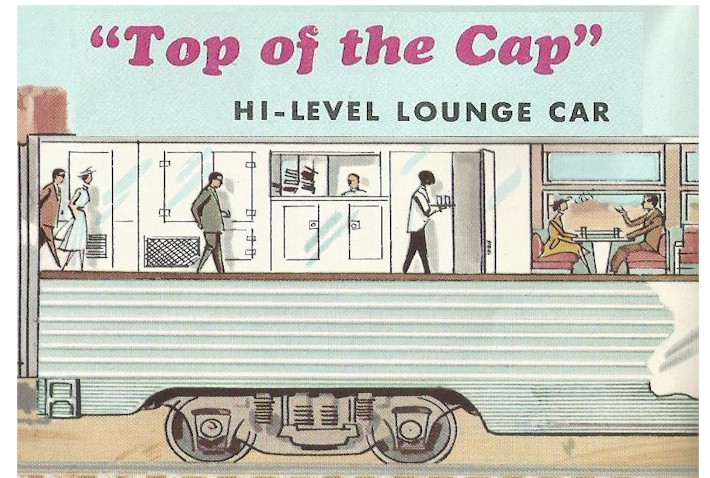 A brochure showing a side-view of the Santa Fe Hi-Level lounge car - now known more commonly as the "Top of the Cap" car
A brochure showing a side-view of the Santa Fe Hi-Level lounge car - now known more commonly as the "Top of the Cap" car
 A diagram showing the upper and lower level of the Hi-Level lounge cars
A diagram showing the upper and lower level of the Hi-Level lounge cars
 The same diagram - zoomed in on the upper level of the Hi-Level "Top of the Cap" lounge car
The same diagram - zoomed in on the upper level of the Hi-Level "Top of the Cap" lounge car
 The same diagram - zoomed in on the lower level of the Hi-Level lounge car; this is part of the Kachina Coffee Shop area
The same diagram - zoomed in on the lower level of the Hi-Level lounge car; this is part of the Kachina Coffee Shop area
 A Santa Fe promotional photo of the upper level of the Hi-Level lounge car
A Santa Fe promotional photo of the upper level of the Hi-Level lounge car
o
 We move now into the 1960's; this is one of the first colored photos of the interior of the Santa Fe Hi-Level lounge car.
We move now into the 1960's; this is one of the first colored photos of the interior of the Santa Fe Hi-Level lounge car.
It is still in its original configuration here; note the Kachina symbols on both sides of the wall in the distance.
As you likely know, Amtrak took over operation of most
intercity passenger service in the United States on May 1, 1971, including the
Santa Fe's remaining trains. It acquired the entire now ex-Santa Fe Hi-Level fleet and
continued to operate them. The primary assignment continued to be the
combined Super Chief/El Capitan, known as the Southwest Limited from 1974–1984 and the Southwest Chief thereafter. The Chicago–Houston, Texas Texas Chief,
another ex-Santa Fe train, also carried Hi-Level coaches (but not usually the lounge cars). With only a
very rare exception, the Hi-Level lounge cars continued to run between
Chicago and Los Angeles.
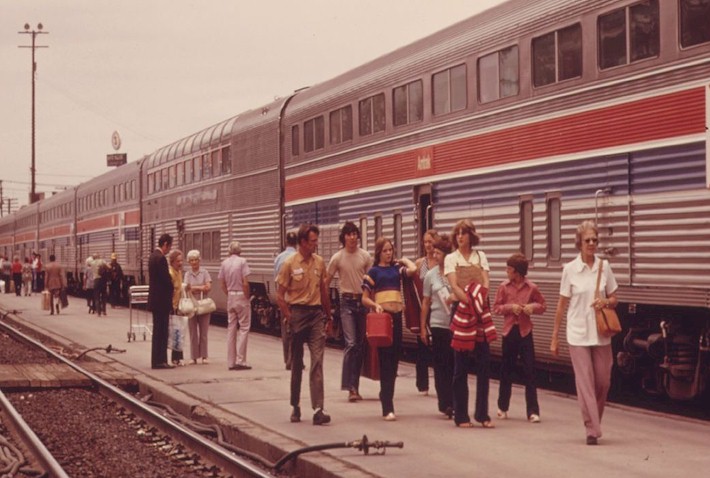
Photo comment from railroad historian Bob
Phillips: If you look very carefully at the picture, you will see the
Amtrak Stripe along the windows from the first window to the
last. This was how most of the ex-AT&SF Hi-Level cars were
done up, right after the start-up of Amtrak on May 1, 1971. It
was sometime, not long after that, the Amtrak Stripes were taken off of
the window level and placed below them. This was done so the
stripes were at same level as on the single level cars. This
decision was made about the same time Amtrak required that ALL
passenger cars operating on Amtrak's trains, regardless of ownership,
to be painted in Amtrak's color scheme.
Besides a paint job on
the exterior, the former Santa Fe Hi-level lounge cars would also see
some other changes after Amtrak took over. For one, the numbering of
the cars changed to fit in with Amtrak's fleet numbering plan... #575 became #9970, #576
became #9971, #577 became #9972, #578 became #9973, #579 became #9974,
and #580 became #9975. After being on the rails for nearly 20 years,
the interior of the cars also got a re-make in the 1970's (a photo will
appear below); you will likely recognize the classic Amtrak orange
making an appearance on the interior of the cars.
As time went on, and Amtrak got organized, its railroad executives were
impressed with the ex-Santa Fe Hi-Levels and used them as the basis for
the design of the bi-level Superliner family of rail cars. The first of
284 "Superliner I" cars began arriving from Pullman-Standard in 1978. As
the Superliners went into service, Hi-Levels could be found on more of
Amtrak's trains throughout the Western United States (the new
Superliners were compatible with the Hi-Level coaches, even though
there was a few inch difference in height). Hi-Level coaches appeared on
the Chicago–San Francisco San Francisco Zephyr, Chicago–San Antonio, Texas–Los Angeles Texas Eagle, and the Chicago-Seattle, Washington/Portland, Oregon Empire Builder. Dining cars displaced from the Southwest Chief filled in on the Ogden, Utah–Los Angeles Desert Wind. For the most part, the Hi-Level lounges remained on the Southwest Chief until the release of enough of the new Superliner Sightseer Lounge Cars were built as replacements.
We spoke with railroad historian Bob Phillips, who notes, "The
Hi-Levels could not run with Superliner Equipment in the beginning, as
they were not compatible, because the diaphrams were not compatible.
They were also steam heated and had diesel generators. In
mid-1981, after they were done running on steam heated trains, a
majority of the cars were sent to the AT&SF Topeka Shops and
re-built. Yes, Amtrak choose AT&SF Topeka Shops to do the work,
rather than their own shops at Beech Grove, Indiana. AT&SF
stenciled this on the inside door of each electrical locker, reading,
'Re-built by AT&SF Topeka Shops 1981.' This is when they were
converted to head-end power, and the steps were added at each end,
along with new diaphrams to be compatible with Superliners.
Needless to say, that is when the diesel generators were removed."
Let's take a look at some more photos from the 1970's and early 1980's of the Hi-Level lounge cars under the now-Amtrak era:
 A view of a Hi-Level lounge Amtrak #9972 (formerly Santa Fe #577) on the Southwest Limited at Albuquerque, New Mexico.
A view of a Hi-Level lounge Amtrak #9972 (formerly Santa Fe #577) on the Southwest Limited at Albuquerque, New Mexico.
Note that this is the original Amtrak paint scheme for the Hi-Level
lounge cars, featuring a wide red stripe, small white stripe, and wide
blue stripe.
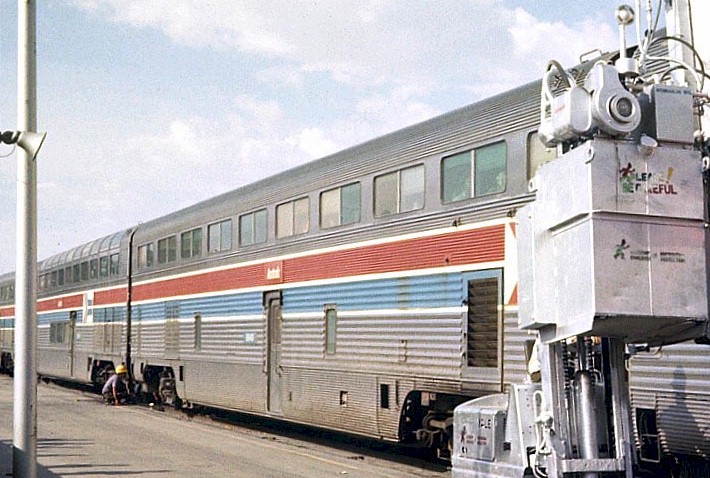 Another view of the Southwest Limited
at Albuquerque. A Hi-Level coach is seen in this photo just ahead of
the Hi-Level lounge car.
Another view of the Southwest Limited
at Albuquerque. A Hi-Level coach is seen in this photo just ahead of
the Hi-Level lounge car.
 Another view of the original paint scheme for the Hi-Level lounge cars after being taken over by Amtrak.
Another view of the original paint scheme for the Hi-Level lounge cars after being taken over by Amtrak.
 Get your model! This model railroad advertisement features the Hi-Level lounge car in its original Amtrak paint scheme.
Get your model! This model railroad advertisement features the Hi-Level lounge car in its original Amtrak paint scheme.
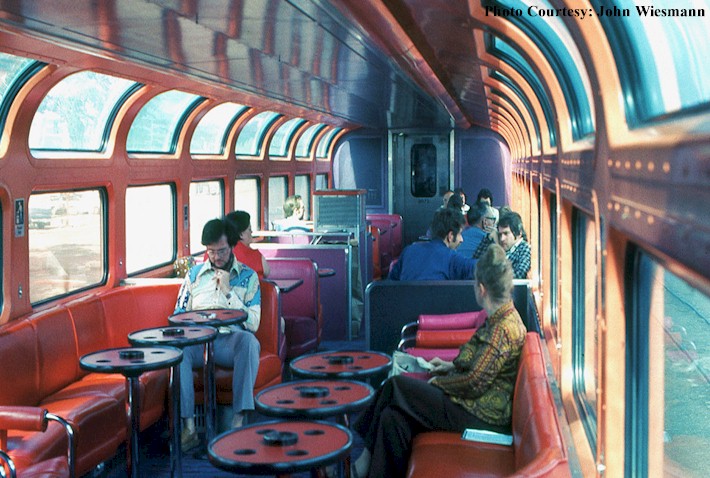 This was what the first re-model of
the interior of the Hi-Level lounge cars looked like after Amtrak took
over. The configuration of the car did not change too much, however
colors were updated (orange!) and different tables were put in that had
ash trays and could hold four cocktail drinks each.
This was what the first re-model of
the interior of the Hi-Level lounge cars looked like after Amtrak took
over. The configuration of the car did not change too much, however
colors were updated (orange!) and different tables were put in that had
ash trays and could hold four cocktail drinks each.
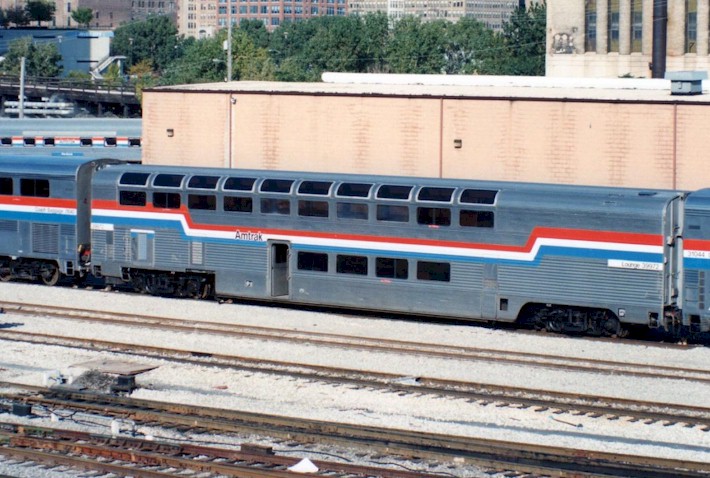 This is the second Amtrak exterior
paint scheme designed for the ex-Santa Fe Hi-Level lounge cars.
Commonly referred to as the "Phase III" paint scheme, it features equal
stripes of red, white, and blue (compared to the previous paint scheme
which featured the red and blue more predominantly).
This is the second Amtrak exterior
paint scheme designed for the ex-Santa Fe Hi-Level lounge cars.
Commonly referred to as the "Phase III" paint scheme, it features equal
stripes of red, white, and blue (compared to the previous paint scheme
which featured the red and blue more predominantly).
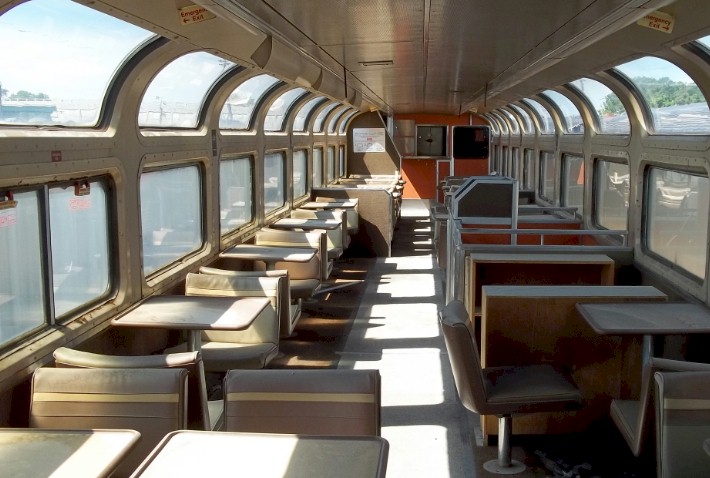
This
was the second interior change that Amtrak did to the ex-Santa Fe
Hi-Level lounge cars -- accomplished sometime in the late 1980's. The
"love seat" couches which were part of the car during the original
Santa Fe design and the first Amtrak refurbishments were now replaced
with tables and single chairs throughout most of the car. These
type of seats and tables are still featured in Amtrak's last remaining
dome car "Ocean View".
After 30 years of faithful
service between Chicago and Los Angeles, the ex-Santa Fe Hi-Level
lounge cars were officially moved off their "home route". This was due
to the fact Amtrak had enough Superliner Sightseer Lounge Cars by the
mid-to-late 1980's to use for all departures of the Southwest Chief.
These new Superliner Sightseer Lounge Cars featured bigger windows and were more modern
(even featuring a piano for a year or so when first launched!) -- and
Amtrak wanted to use the new Sightseers on what is considered one of the
most scenic western long distance routes. However, until a second order
of Superliner cars was completed in the early 1990's (sometimes referred
to as "Superliner II's"), Amtrak still did not have enough of the
Sightseer Lounge Cars for each of its western routes. So, the ex-Santa
Fe Hi-Level lounges were moved off the Southwest Chief to such routes as the Texas Eagle (Chicago to San Antonio, with through service to Los Angeles a few times per week), and on the Sunset Limited (a train that operated several times per week between New Orleans and Los Angeles). When
upgraded to HEP (head-end power), a "3" was added in front of the then-current car
numbers. Through the 1990's, Amtrak was still running all six of
the original Santa Fe Hi-Level lounge cars - now known as #39970,
#39971, #39972, #39973, #39974, and #39975.
A little-remembered fact was that during their time in the late 1980's and early 1990's on the Texas Eagle and Sunset Limited, the
cars were referred to by Amtrak as "See-Level Lounges" (see clip from
timetable below)... this of course is not to be confused with the newer
Superliner Sightseer Lounges. The interior of the Hi-Level Lounge Cars
received an upgrade to the interior pictured above.
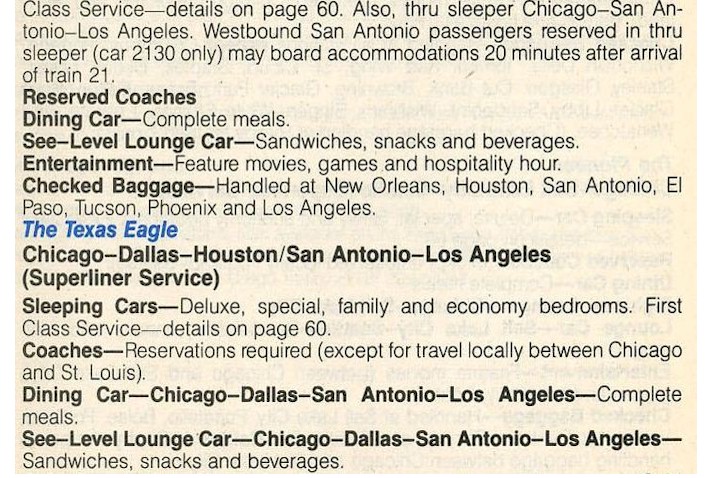 A description in a 1989 Amtrak timetable shows the Santa Fe Hi-level lounges being called "See-Level Lounges" now
A description in a 1989 Amtrak timetable shows the Santa Fe Hi-level lounges being called "See-Level Lounges" now
Another often-forgot fact is
See-Level Lounge Car #39973 (which would later go on to become Pacific
Parlour Car "Santa Lucia Highlands") was on the Sunset Limited
in 1993 during the Big Bayou Canot wreck. Many people lost their lives
in this tragedy, but the ex-Santa Fe Hi-Level lounge survived with
little damage because it was towards the back of the consist, and was
one of few cars that stayed on the bridge. A photo of the accident is
posted below; several engines and Superliner coach cars were sent into
the bayou. The lounge is not shown here because it was toward the rear,
and again, stayed upright on the bridge. This could have easily been
the end for #39973.
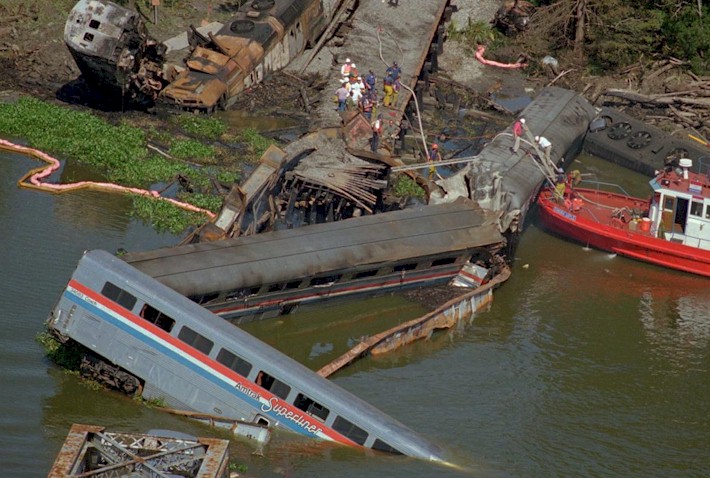 Former Hi-Level Lounge #39973 (not pictured here) was part of the Sunset Limited accident in 1993
Former Hi-Level Lounge #39973 (not pictured here) was part of the Sunset Limited accident in 1993
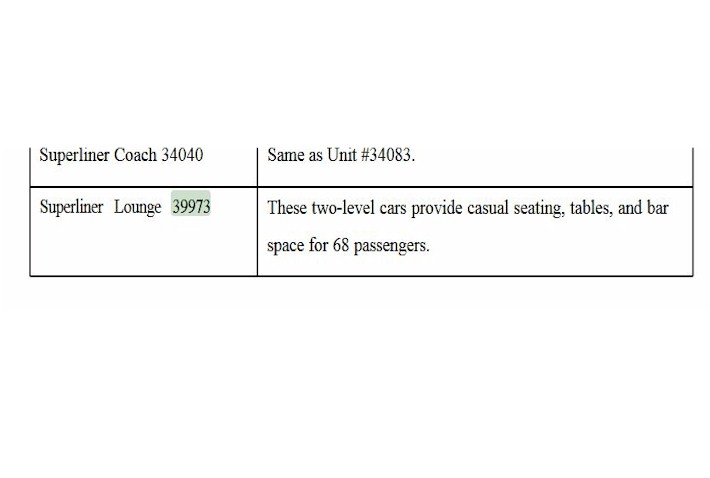
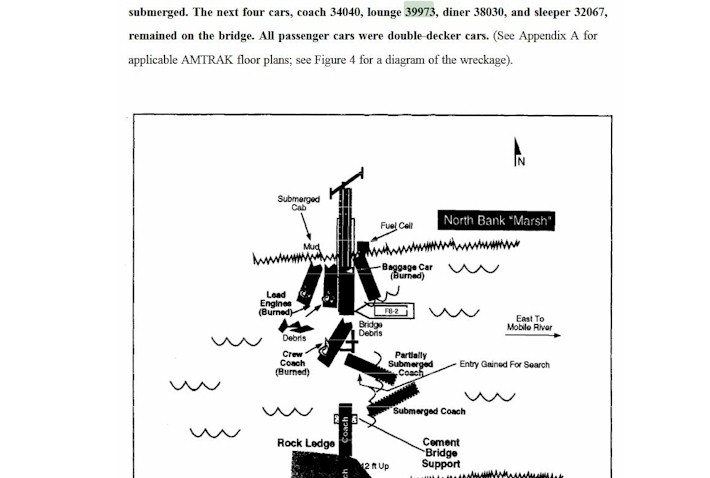 These documents are from the FRA
investigation into the 1993 Big Bayou Canot accident; a keen eye
reveals that the Hi-Level lounge is incorrectly identified in the
reports as "Superliner Lounge #39973". This is not correct, but they do
look that much alike to some who don't know the history and
distinctions between these two cars.
These documents are from the FRA
investigation into the 1993 Big Bayou Canot accident; a keen eye
reveals that the Hi-Level lounge is incorrectly identified in the
reports as "Superliner Lounge #39973". This is not correct, but they do
look that much alike to some who don't know the history and
distinctions between these two cars.
By the early-to-mid 1990's,
Amtrak had built enough Sightseer Lounge Cars (with the release of
"Superliner II" cars) for all of its western routes now, including the Sunset Limited and Texas Eagle,
on which the cars had been running for between five and ten years at
that point. The decision was made to "retire" the ex-Santa Fe heritage
Hi-Level cars; they were sent to Amtrak's shops at Beech Grove, Indiana
(outside of Indianapolis), awaiting a decision by Amtrak to either sell
them off to a private railroad car group/owner, or possible sell them
for scrap. By 1994, the cars were 40 years old, and it was looking like
this was really going to be the "end of the line" for these historic
lounge cars from the days of the Santa Fe.
Before the historic Hi-Level lounge cars could face either of those
fates -- in stepped a person by the name of Brian Rosenwald, an
executive from Amtrak who would often take the Santa Fe in the late
1950's and early 1960's between his home in Chicago (he grew up in the
northern suburbs) and New Mexico (where had extended family). Brian
remembered riding the Hi-Level lounge cars as a child, and now that
part of his youth was sitting in Indiana - about to be part of history.
You could say the cars just happened to be in the right place at the
right time... and overseen by the right person. Brian approached his
then-boss Gil Mallery with the idea of refurbishing the cars and
turning them into a special "first class" type of lounge car that sleeping car passengers
could enjoy.
Since only six of the cars were in existence, it would be a real
stretch to put them on one of the two-night long-distance trains and
guarantee that they would be on every departure. Brian realized that
the cars could easily be put on the one-night Coast Starlight which operated between Los Angeles, the San Francisco Bay Area, Portland, and Seattle. Given the schedule of the Coast Starlight,
only four of these first class lounge cars would have to be on the road at one
time -- leaving two to be spares or to go through routine maintenance schedules.
The Coast Starlight was also
a good choice because the route through California, Oregon, and
Washington features almost constant beautiful scenery -- whether it's
the Pacific Ocean in Southern California, Mount Shasta in Northern
California, the Cascades in Oregon, or the Puget Sound near Tacoma,
Washington.
During late 1994 and into early 1995, Amtrak spent $3,000,000 in order
to completely refurbish five of the six former Sante Fe Hi-Level lounge
cars -- giving birth to what has been known for the past 23 years as
the Pacific Parlour Car. The decision was made to not spend the money
to refurbish car #39971 because it was in the worst shape out of all
six -- however Amtrak would keep this car in its possession for a period
of time as a "spare" in Los Angeles in case it was needed on the train.
It still received the exterior Pacific Parlour Car branding, but did not
get the refurbished interior that most people are familiar with today.
The new Pacific Parlour Cars
(again, with the exception of #39971)
featured upstairs lounges with mahogany-paneled walls, glass sconces,
domed viewing windows, swivel armchairs, couches, banquettes and full
bars, and downstairs cinemas with big-screen TV's and classic movie
theater seating for 19. Musicians and entertainers were even brought in
for a short period of time to perform on these cars. Brian Rosenwald's
idea for these cars became a
huge success for Amtrak. There was (ugh! I hate using past tense here,
but that is what it is now!) nothing like them on any other train in
the Amtrak system. Rosenwald added a complimentary buffet breakfast for
passengers and even a mid-afternoon wine tasting. The result was a 77%
jump in first-class revenue between 1994 and 2001. Passengers
were loving what Rosewald called a a "land cruise experience". The new
motto "Superior Service" was catching on for the Coast Starlight.
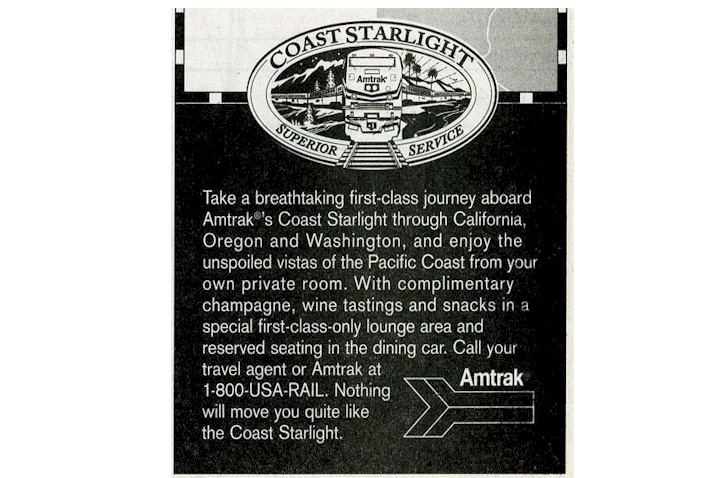 An announcement in the 1995 timetable talks about the new First Class Lounge Car that was going to be offered.
An announcement in the 1995 timetable talks about the new First Class Lounge Car that was going to be offered.
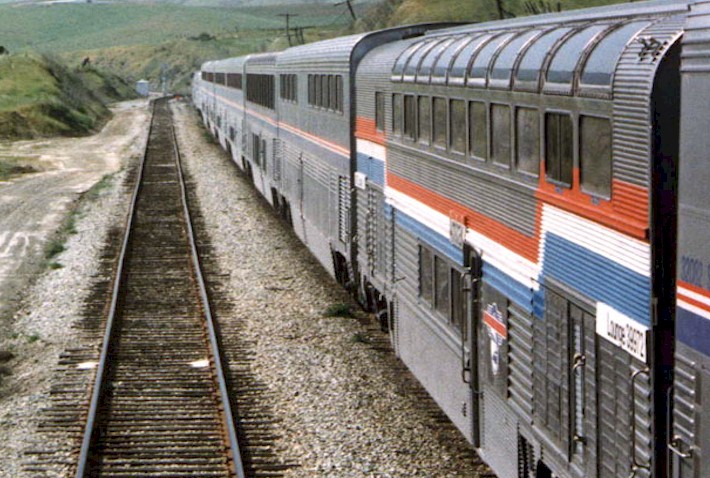 Lounge Car #39972 begins its
transition into a Pacific Parlour Car -- still in old Amtrak paint
here, but with a new Pacific Parlour logo by the door.
Lounge Car #39972 begins its
transition into a Pacific Parlour Car -- still in old Amtrak paint
here, but with a new Pacific Parlour logo by the door.
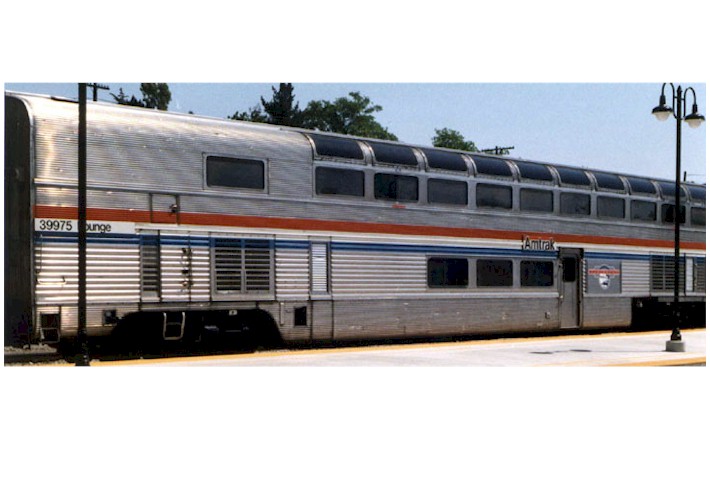 Amtrak's Pacific Parlour Car #39975, still in its original paint job, but with a Pacific Parlour Car sign by the door.
Amtrak's Pacific Parlour Car #39975, still in its original paint job, but with a Pacific Parlour Car sign by the door.
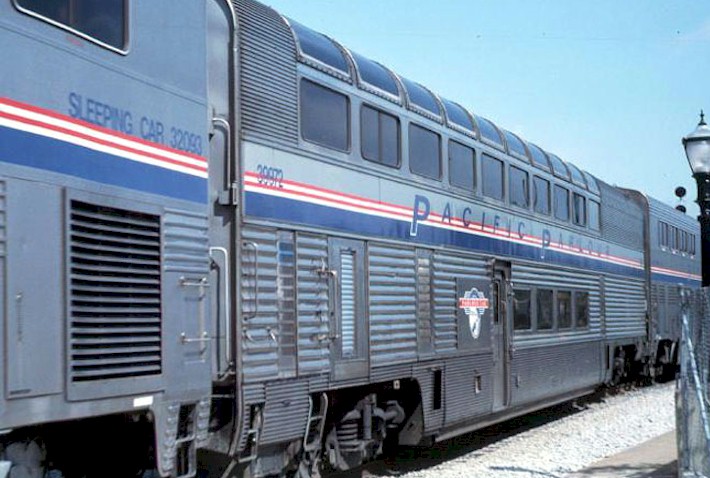 The new paint scheme release in the
late 1990's for the Pacific Parlour Car -- the "Pacific Parlour"
lettering matched that of "Superliner" that many cars featured at the
time.
The new paint scheme release in the
late 1990's for the Pacific Parlour Car -- the "Pacific Parlour"
lettering matched that of "Superliner" that many cars featured at the
time.
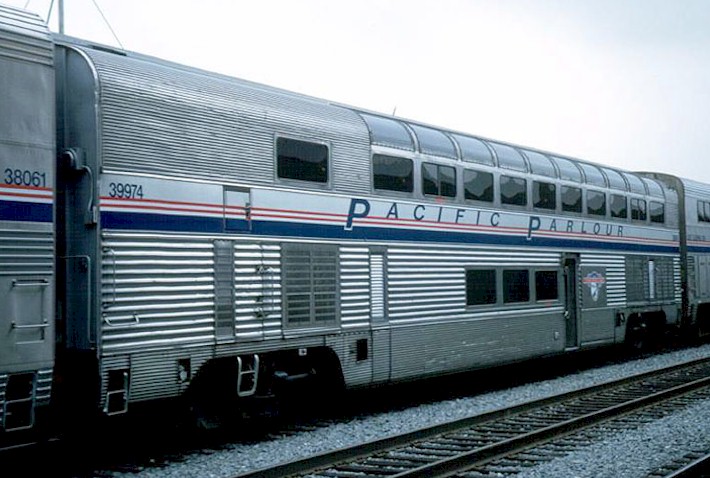 Another view of the Pacific Parlour Car in its new paint scheme and lettering.
Another view of the Pacific Parlour Car in its new paint scheme and lettering.
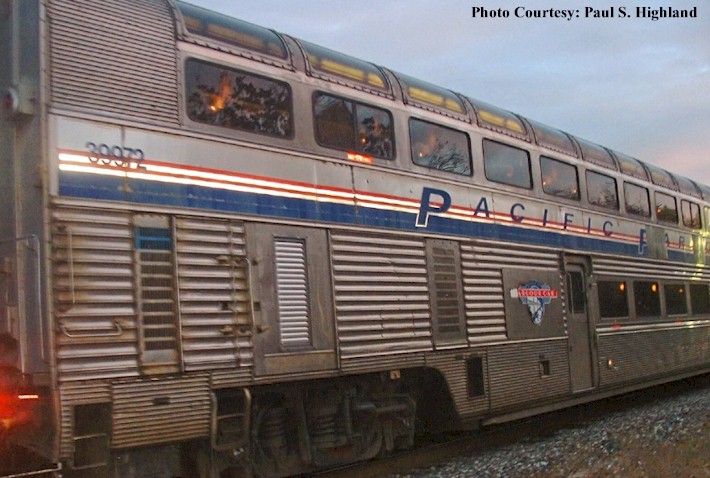 Pacific Parlour Car #39972 in its
"Pacific Parlour" lettering -- note the paint is beginning to get quite
worn out by the early 2000's here.
Pacific Parlour Car #39972 in its
"Pacific Parlour" lettering -- note the paint is beginning to get quite
worn out by the early 2000's here.
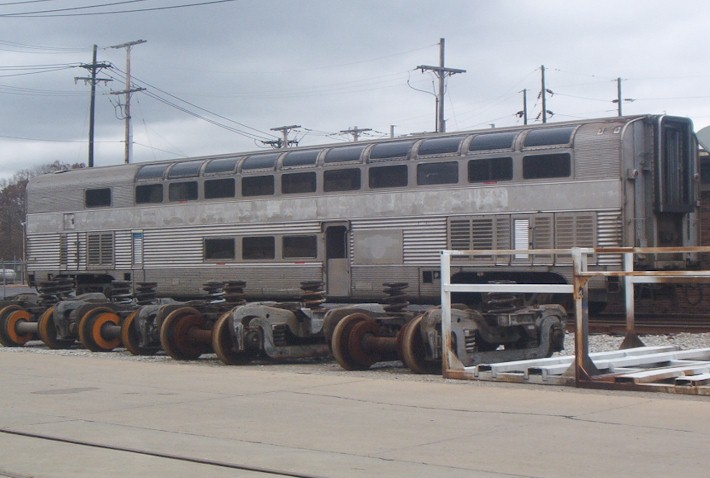 A shot of a Pacific Parlour Car in
Beech Grove, Indiana in 2006 - it will be getting a new exterior design
put on in the coming weeks.
A shot of a Pacific Parlour Car in
Beech Grove, Indiana in 2006 - it will be getting a new exterior design
put on in the coming weeks.
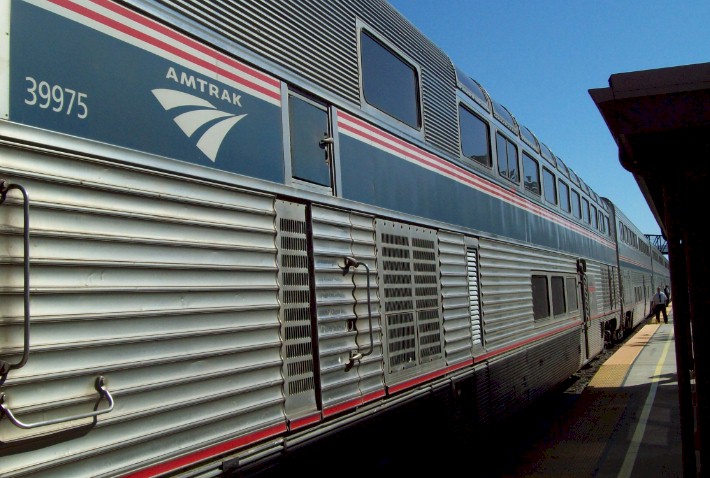 This was the design on the exterior of
the Pacific Parlour Cars for much of their last decade of service --
often referred to as a "Phase IV" paint job.
This was the design on the exterior of
the Pacific Parlour Cars for much of their last decade of service --
often referred to as a "Phase IV" paint job.
The
year 2000 marked the last time all six of the ex-Santa Fe Hi-Level
lounge cars would be part of the same fleet; they survived together for
17 years of the Santa Fe and 29 years of Amtrak up until this point. In
early 2001, management at Amtrak decided that is really only needed
five of these lounge cars given the Coast Starlight
schedule (four on the road at any given time and one spare) and sold
off the un-refurbished #39971 car to a private rail owner. (Stay
tuned... in the coming weeks we plan to do a special article here on
TrainWeb just about this car -- what happened to it? where is it
now? what does the interior look like in 2018?)
The decision was also made to give actual names to the five remaining
Pacific Parlour Cars... all had to do with areas the train passes
through between Los Angeles and Seattle. #39970 was now called
"Columbia Valley", #39972 was now called "Napa Valley", #39973 was now
called "Santa Lucia Highlands", #39974 was now called "Sonoma Valley",
and #39975 was now called "Willamette Valley".
Highlights of the Pacific Parlour Car grew to include daily afternoon
wine tastings that were free to sleeping car passengers... and the
wines were coordinated so you would be sampling from the area of the
country you were traveling through. For example, northbound passengers
going from Los Angeles to Seattle on Train #14, would get a wine
tasting featuring California wines on Day #1, and then
Oregon/Washington wines on Day #2. Amtrak also added dining
service to the Pacific Parlour Car. Instead of eating meals in the
traditional dining car, sleeping car passengers could now choose to
have a meal served to them in the Pacific Parlour Car! This was
really meant to elviate overcrowding in the dining car, but was
received very well. One of the fun features were people could get their
own dining table in the Pacific Parlour vs. having to share a table
with strangers in the traditional Superliner dining car. Even parties
of one could have their own table in the Parlour.
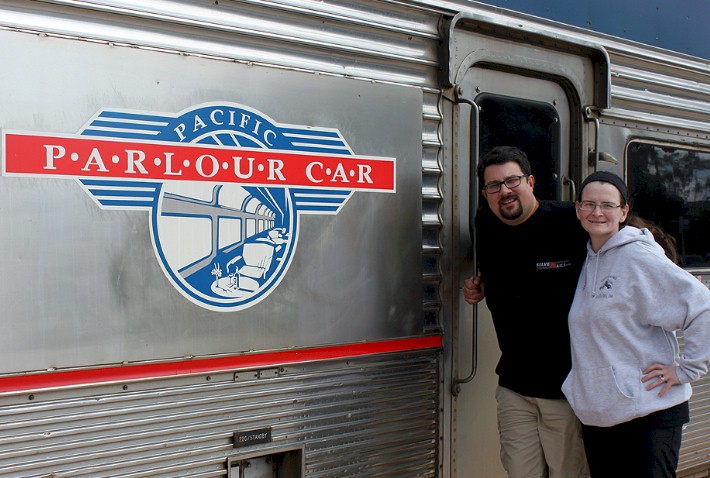 The authors of this article, Robert & Kandace Tabern, have enjoyed many trips on the Pacific Parlour Cars in recent years.
The authors of this article, Robert & Kandace Tabern, have enjoyed many trips on the Pacific Parlour Cars in recent years.
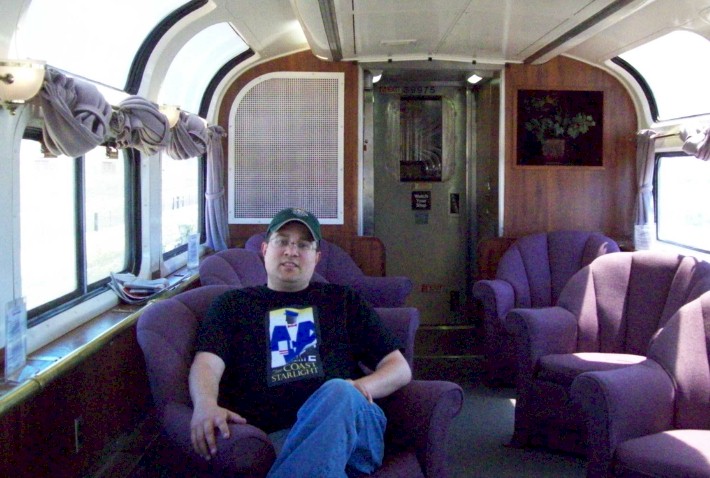 Author Robert Tabern enjoys the Pacific Parlour Car's "big purple comfy chairs", as seen here in May 2009
Author Robert Tabern enjoys the Pacific Parlour Car's "big purple comfy chairs", as seen here in May 2009
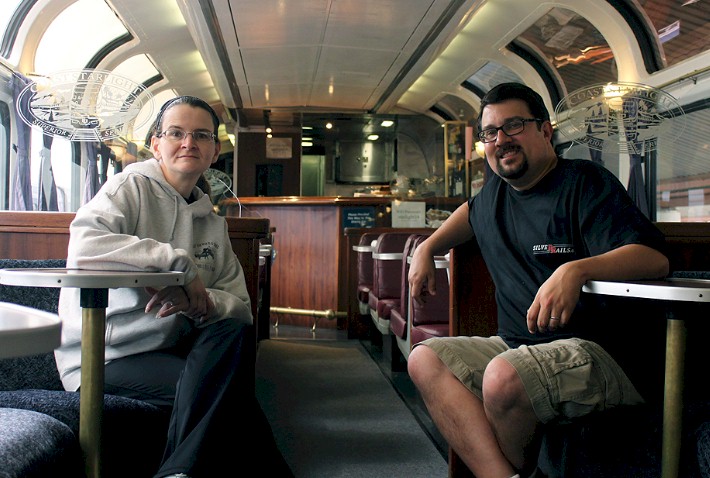 Authors Robert & Kandace Tabern enjoy some time together sitting on the couches in the Pacific Parlour Car.
Authors Robert & Kandace Tabern enjoy some time together sitting on the couches in the Pacific Parlour Car.
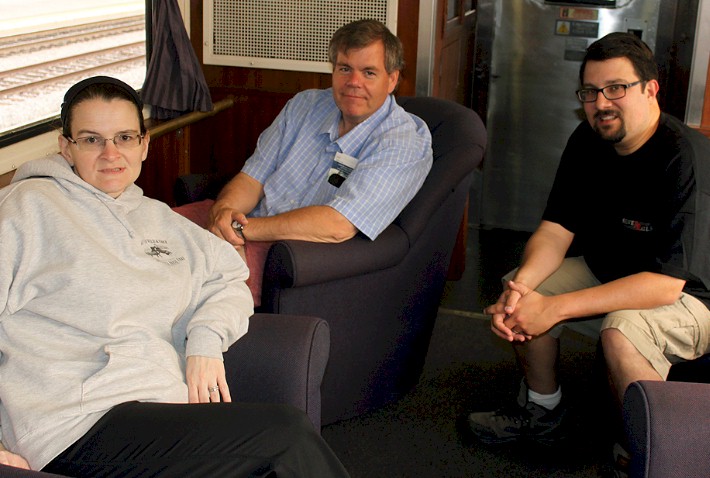 Authors Robert & Kandace Tabern enjoy sharing time with their friend Mike Pace on the Pacific Parlour Car in 2015
Authors Robert & Kandace Tabern enjoy sharing time with their friend Mike Pace on the Pacific Parlour Car in 2015
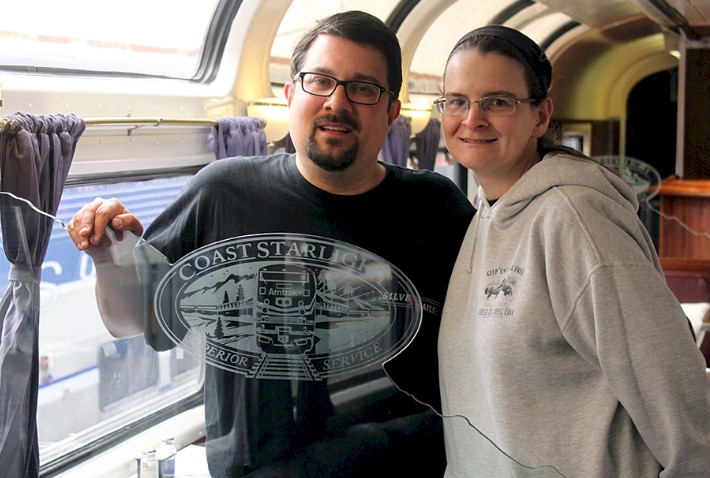 One of the beautiful features of the
car was the etched glass with the Coast Starlight logo from 1995; it
survived through the last run in 2018.
One of the beautiful features of the
car was the etched glass with the Coast Starlight logo from 1995; it
survived through the last run in 2018.
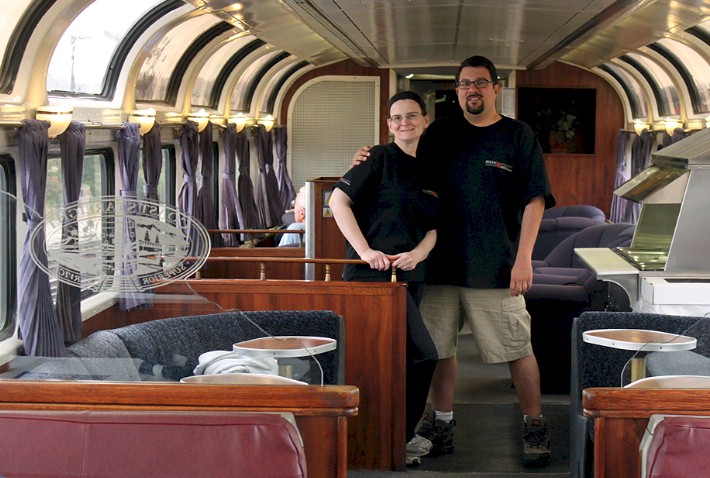 This photo provides a good view of the
interior of the Pacific Parlour Car; note the "comfy purple chairs"
behind Robert and Kandace. The buffet serving area and stairs are
located next to them. The couches and tables are in front of them.
This photo provides a good view of the
interior of the Pacific Parlour Car; note the "comfy purple chairs"
behind Robert and Kandace. The buffet serving area and stairs are
located next to them. The couches and tables are in front of them.
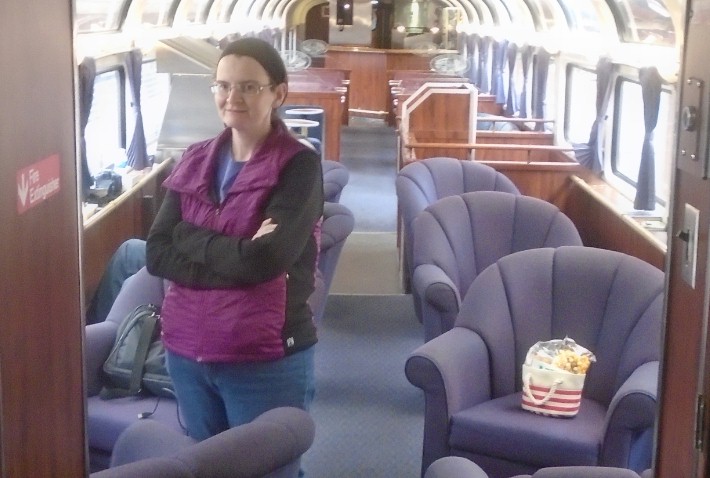 Kandace Tabern and the Pacific Parlour Car's famed "purple comfy chairs".
Kandace Tabern and the Pacific Parlour Car's famed "purple comfy chairs".
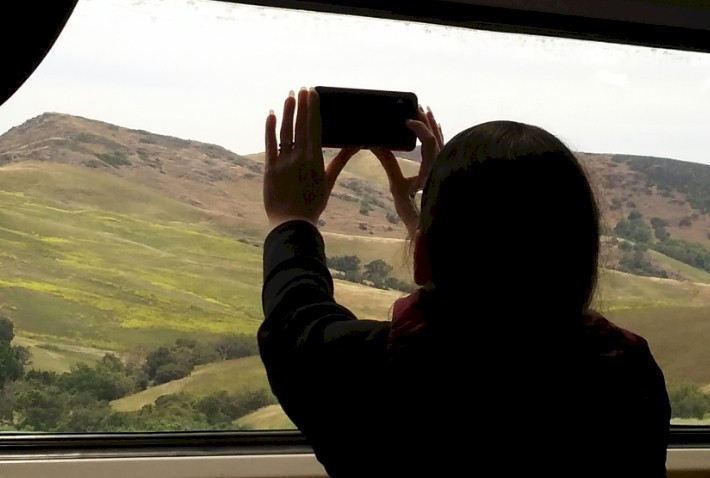 Kandace Tabern uses her cell phone to take photos of the California Coastal Mountains from the Pacific Parlour Car.
Kandace Tabern uses her cell phone to take photos of the California Coastal Mountains from the Pacific Parlour Car.
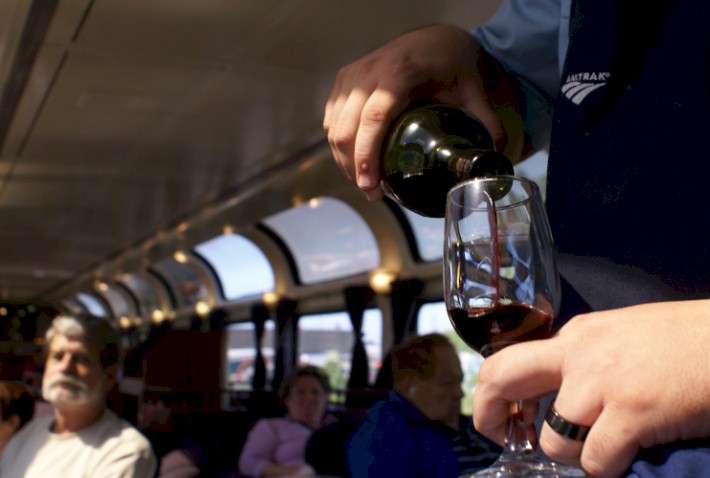 Daily wine tastings were often a highlight in the Pacific Parlour Car, as seen here in July 2017.
Daily wine tastings were often a highlight in the Pacific Parlour Car, as seen here in July 2017.
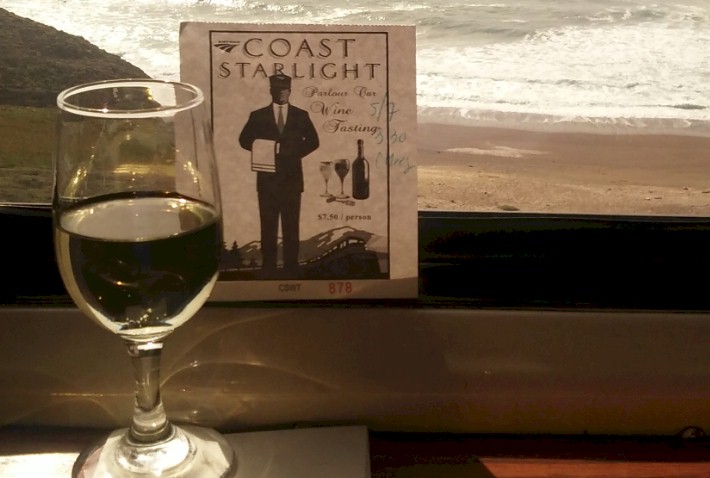 A glass of white wine and the Pacific Ocean out your window of the Pacific Parlour Car -- could it get any better than this?
A glass of white wine and the Pacific Ocean out your window of the Pacific Parlour Car -- could it get any better than this?
Amtrak seemed
to have entered into a very different culture as the calendar turned
into the 2010's. Some members of Congress took notice of the Coast Starlight
and began to grumble that passengers enjoying "free wine and cheese" on
a government-subsidized train. That was not really the truth because of
the cost of the wine and cheese tasting offer on the train was built
into the sleeping car fare that was being paid. However, Amtrak bowed
down to the pressure of some Congressmen and eliminated the wine and
cheese tasting on all of its long distance trains - including the Coast Starlight, Empire Builder (held through Montana on Day #2 of the trip), and the Lake Shore Limited
(for eastbound passengers out of Chicago; was offered instead of a full
dinner which was previously done). The wine tasting was eventually
restored on the Pacific Parlour Car, with passengers paying a $7.50 fee
to participate.
Most cuts would come to the Coast Starlight and
other Amtrak long distance trains as the 2010's rolled on. Daily
newspapers were no longer offered in the sleeping cars. Trivia games in
the Pacific Parlour Car were cut, along with the trivia prizes.
Souvenir selections in the Pacific Parlour were dwindled down to
nothing, or maybe a single cup. All-day juice and coffee in the
sleepers was no more. Classy railroad China was replaced with plastic
ware -- even wine glasses transitioned into plastic cups believe it or
not! Fresh flowers in the dining car and the Pacific Parlour were cut.
The list goes on and on.
It's no surprise that many of these changes went down after Brian
Rosenwald, the brain-child of the Pacific Parlour Cars decided to
retire. Ironically, he owns a wine shop on the north side of Chicago
today that features some of the wines that were available in the early
years of the Pacific Parlours! We have been to the shop several times
and really enjoy the atmosphere and selection.
In 2016, Amtrak announced that the famed Pacific Parlour Cars would no
longer operate during the less-traveled months of January, February,
and March. Many saw this as a possible "writing on the wall" that these
historic ex-Santa Hi-Level lounges would not be around forever. Amtrak
mentioned in their news release that these cars would be going through
maintenance work during this period to keep them in operational mode
during the busier seasons. However, this came into doubt when many
employees and passengers saw the Pacific Parlours just sitting in the
train yards in Los Angeles during the "maintenance period" with very
little work actually being done on them. A similar period of no
Pacific Parlour Cars occurred between January and March 2017.
Amtrak issued a similar statement announcing the cars would be pulled
again between January and March 2018.
The "end of the line" announcement for the Pacific Parlours took place
on January 17, 2018. On this date Amtrak issued an advisory to
employees that the Pacific Parlour Cars would only run on a limited
schedule the next two weeks -- and after that -- they would be prepared
for either sale to a private railroad car owner or even be
scrapped. The final northbound run of the Pacific Parlour Cars
took place between Los Angeles and Seattle on February 2 and 3, 2018...
and the final southbound run of the Pacific Parlour Cars took place
between Seattle and Los Angeles on February 4 and 5, 2018. The
last run of the Parlour Cars featured two back-to-back, something that
had never occurred... #39970 and #39972 were open to passengers who
rode. The arrival of #14 into Los Angeles on February 5, 2018
marked the end of a 64-year era for the ex-Santa Fe Hi-Level lounge
cars... whatever happens to them... they will not be in public daily
service any longer.
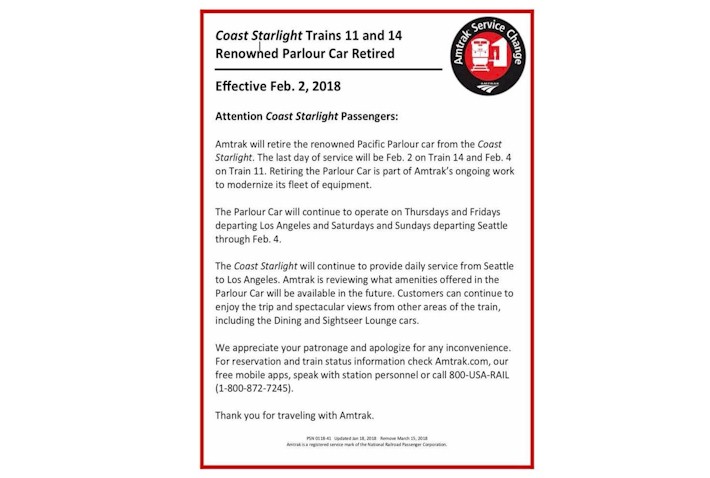 Amtrak issued this advisory on January 17, 2018, marking the end of the Pacific Parlour Car service on February 5, 2018.
Amtrak issued this advisory on January 17, 2018, marking the end of the Pacific Parlour Car service on February 5, 2018.
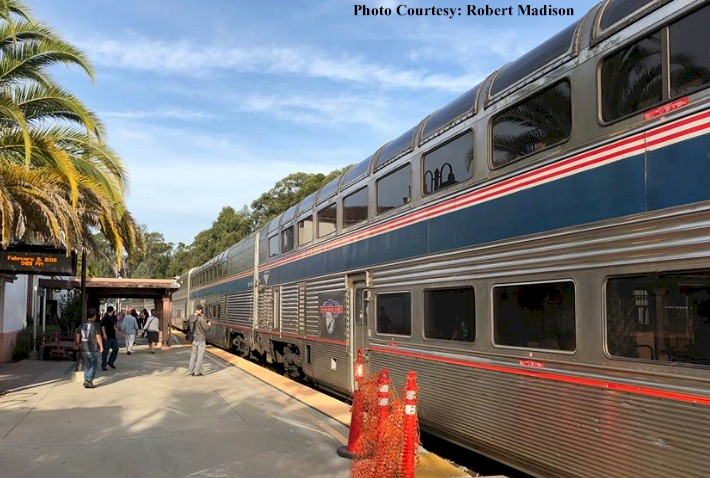 Two Pacific Parlour Cars were added
for the last round trip between February 2-5, 2018, as seen here on #14
in San Luis Obispo, CA.
Two Pacific Parlour Cars were added
for the last round trip between February 2-5, 2018, as seen here on #14
in San Luis Obispo, CA.
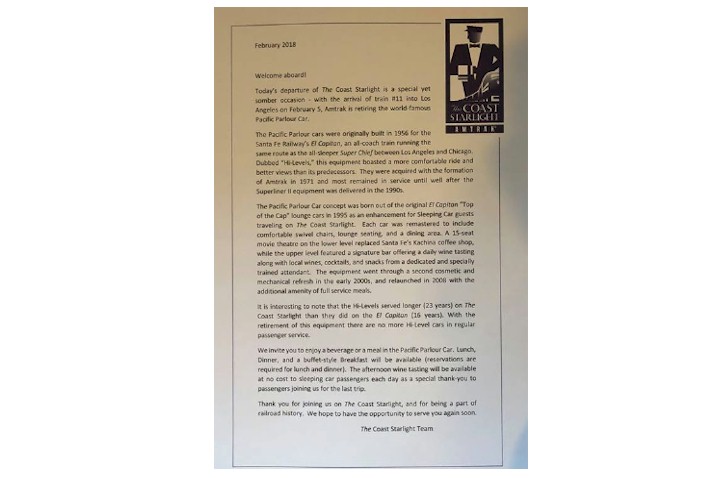 A special commemorative note was given
out to each sleeping car passenger on the last run of the Pacific
Parlours in February 2018.
A special commemorative note was given
out to each sleeping car passenger on the last run of the Pacific
Parlours in February 2018.


















































